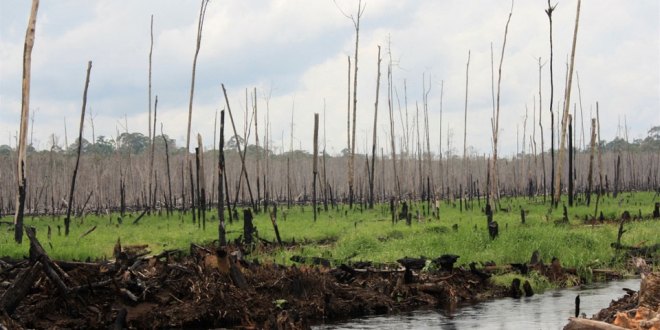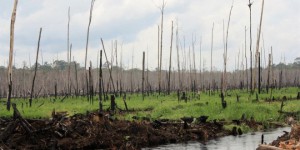Economic downturn the major cause of environmental degradation .
Simba Moyo
Poverty has been cited as the chief cause of environmental degradation in Zimbabwe as loss of economic activities and opportunities have resulted in the poor to depend more on their immediate environment for survival causing over-exploitation of resources.
As such the government has been called to sort out the economy so that people are gainfully employed, as well as to capacitate the Environmental Management Agency so that it effectively plays its role of enforcing regulation that protects the environment.
Poverty Reduction Forum Trust (PRFT) told ZWNEWS that the continuous exploitation of the environment is resulting in it being unsustainable leading to more poverty and environmental related problems such as droughts, air and water pollution, deforestation, erosion, and poor sanitation.
“The government has the duty to ensure that the welfare of its citizens is sufficiently met in a sustainable manner. One way of achieving this is by providing an environment where jobs are created so that people are gainfully employed; generate income in order to meet their basic needs,” says PRFT.
Environmental degradation is mainly caused by too much pressure on the immediate environment for daily livelihood. Poor people are forced depend only on natural resources such as firewood, agriculture, water and medicines, +for survival.
Small-scale mining activities especially along the Great Dyke has caused more harm than good to the environment and has exacerbated poverty as some families have met with fatalities when the shallow mine shafts collapse lives are lost and families are left more vulnerable.
This is evident in areas like Insiza and Whandara in Shurugwi where the majority of the poor are resorting to unsustainable gold mining activities to sustain themselves after the downsizing and closure of mining companies in those areas.
Be that as it may studies have shown that small scale artisanal miners in gold mining areas have also been exposed to mercury poisoning. It is estimated that 1.5 million small scale miners, are at risk with calculations done proving that more than 50 tons of this harmful chemical is being used annually in gold processing.
PRFT says poverty forces one to venture into more extensive agriculture by clearing marginal land for cultivation. This will expose the soil to destructive environmental forces such as erosion and siltation of rivers.
Again, he says, population pressures as well as government policies which provided incentives for people to move into these areas played a large part in converting large tracts of forest lands into permanent agricultural lands.
The resettlement programme in Zimbabwe consumed a lot of forestry land and exposed the natural resource to fuller human exploitation. He adds that there is a large body of literature which states that population growth which is caused by poverty is a prime cause for environmental degradation.
Due to the lack of sufficient income people start to use and overuse every resource available to them when their survival is at stake.
PRFT adds that dependence and lack of an alternative or substitute resource to a finite and basic resource are the chief factors that lead to overexploitation of natural resources. According to him, this is largely underpinned by the economic cost of the alternatives such as electricity and LP gas whose costs of are far beyond the reach of most of the poor.
PRFT suggests that communities should mobilize themselves to develop proactive environment protection plans such as Communal Area Management Programme for Indigenous Resources (CAMPFIRE) that take into account local social, economic, and environmental conditions as well as community values and create a sense of local ownership of issues and solutions and encourage accountability.
Innovation at community level should be encouraged to tackle environmental challenges such as waste disposal, excessive use of natural resources, to stem the rate at which environmental degradation is taking place. This requires commitment from all stakeholders in the community such as the private sector, civil society organizations and the citizens to collaborate and complement each other’s efforts in stemming environmental degradation.
“Currently the laws that are contained in the EMA Act are not mutually inclusive of poverty reduction policies. There is need to pu+rsue environmental protection that have poverty reduction foresight. Hence it is critical for the government a+nd all other key stakeholders to implement environmental legislation that balances both environmental sustainability and poverty reduction.”
Meanwhile, the then Ministry of Public Service and Social Welfare’s 2003 Poverty Assessment Study Survey (PASS II) main report that was published in 2006 revealed that poverty is both a cause and consequence of environmental degradation. The survey, which was the largest poverty survey ever conducted in the country also revealed that the poor constitutes the greatest proportion of those who have direct negative impact on the environment, through unsustainable use of natural resources.
At the same time, on the 5th of June every year, the world commemorates the World Environment Day that was proclaimed in 1972 by the United Nations General Assembly after growing concerns on environmental degradation.
Zimbabwe is a signatory to various multilateral environment agreements that focuses on the links between poverty and environment degradation such as United Nations Convention on Biological Diversity (CBD) among others. National development frameworks and policies that elude the poverty- environment linkages include the micro-economic framework (2005-2006), Draft National Environment Policy (2005) and the Millennium Development Goals (MDGs)





